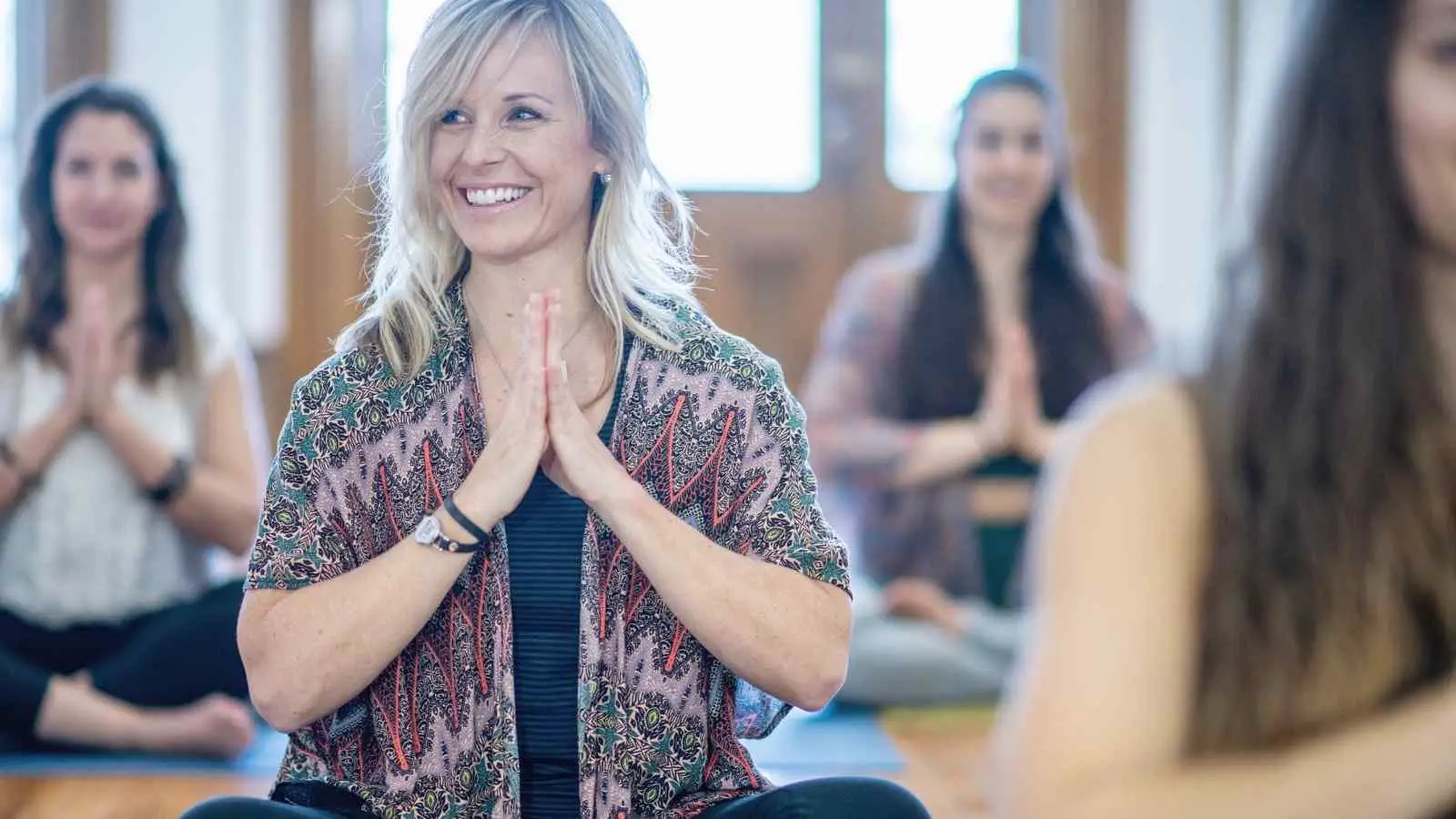Educating, guiding, and training others to become more present and mindful is one of the most rewarding jobs in the world. If you’ve come across this article, chances are meditation has profoundly impacted your life, and you’re feeling called to share its benefits with others.
You might also be wondering how to become a successful meditation teacher and stand out from others.
These are the 12 tips on how to become a successful meditation teacher and remain an expert in your field:
- Clarify your mission
- Try different styles
- Know the benefits of meditation
- Learn about breathing techniques
- Study mudras and mantras
- Find your voice
- Give regular classes
- Structure your sessions
- Get certified
- Niche down
- Teach meditation to kids
- Be visible
Deepening your knowledge in the above areas will set you on the path to becoming a successful meditation teacher. So let’s discuss each one in more detail.
Get clear on your mission
Meditation is a universal practice, meaning it can benefit everyone. However, our experience with meditation is also personal, as everyone sits down to meditate for their own unique reasons.
Before you start teaching meditation, you should understand how the practice helped you personally. Why is this important? Because your unique experience will likely become your mission for sharing meditation with others.
For example, suppose you find meditation an antidote to a stressful, fast-paced lifestyle. In that case, you might feel you want to help other busy professionals find more peace and stillness in their day. Or, if meditation helped you overcome insomnia, you might feel the desire to share the powerful practice with others who struggle with sleep problems.
If you look at the most successful spiritual and meditation teachers, one thing they all have in common is a clear purpose. The practice they teach profoundly affected their lives, and they use that experience as part of their story to help others live happier and healthier lives, too.
Getting clear on your mission will help you craft the message you want to send to your students and understand the type of people you can help the most. Knowing your WHY will also help you stay focused on your goals, setting a solid foundation for success.
Experience different types of meditation
When people begin practicing meditation, they start with one style, unaware there are many ways to enter a meditation state. In fact, there are more than 12 types of meditation, ranging from chanting to walking and visualizing.
If you want to become a successful meditation teacher, you should try a handful of different meditation styles. By doing this, you can teach your students that there is a style for everyone and teach them a few different ones, so they can see what works best for them.
Having one or a few favorites is fine. Still, basic knowledge and experience with several styles will give you more tools to help your students. For example, suppose you start to teach someone who has never meditated in their life and finds it challenging to sit still in traditional seated meditation. Over time, it will become easier for them, but the initial difficulty could be enough for them to give up.
However, combining short periods of seated meditation with walking or dynamic meditation styles will reduce the overwhelm. So by knowing the different types of meditation, you can “prescribe” the one most suited to them, making the goal of learning to meditate more achievable.
Know the benefits of meditation
As a meditation practitioner, you know some of its benefits from your personal experience. However, the practice has many benefits, so likely, you have not experienced them all.
As a teacher, you’ll have a diverse range of people coming to you looking to try meditation for different reasons. Knowing what meditation can and can’t help with will allow you to give your students the correct information and manage expectations.
Let’s say a very busy and tired professional comes to you who wants to use meditation to gain more energy. You need to be able to explain that practicing meditation can help them sleep better at night, which may increase their energy levels throughout the day. Setting their expectations and making it clear that meditation cannot replace sleep will prevent misconceptions.
To be a trusted and reputable meditation instructor, you should also know about any scientific evidence around the practice. For example, if a student suffers from insomnia, explain the benefits of Yoga Nidra and how it is scientifically proven to help reduce this condition.
Learn about breathing techniques
The breath is a powerful tool that can help your students find focus and presence and, thus, go deeper in their meditation practice. Many deep breathing techniques, such as Alternate Nostril Breathing (Nadi Shodhana), are excellent ways to prepare for meditation as it balances both hemispheres of the brain.
By learning some of the most common breathing techniques, you’ll have more tools in your toolbox when it comes to helping your students meditate. For example, if a student struggles to quiet their mind during meditation, you can introduce some calming breath work.
Furthermore, you should study the different breathing techniques and their unique benefits. This is important as if you are leading a calming meditation to help someone sleep, energizing breathwork like Bhastrika (breath of fire) will have the opposite effect of what you want.
Study mudras and mantras
Aside from breathing techniques, mudras and mantras are two other things that can be combined with meditation. A mudra is a symbolic hand gesture that you hold during meditation.

Each mudra has specific healing or energetic qualities, so by learning all the different ones, you’ll be equipped to teach the ones most suited to your students. Plus, if you teach chakra meditation, mudras are particularly useful. One or more hand gestures are associated with each of the seven major chakras, carrying the same energy.
A mantra is a sacred sound or word you can chant during a meditation. Repeatedly chanting mantras is a specific style of meditation called mantra meditation. The chanting helps you remain focused and clears the mind of excessive thoughts.
However, you can use mantras in any meditation as the sound vibrations have healing and calming qualities. “Om” is the most commonly chanted mantra, which is said to be the first sound of the universe. Chanting Om a few times in your classes can help calm the mind and soothe the soul.
While mantras date back to the middle Vedic period, modern-day neuroscientists have found evidence that backs up the benefits of mantras. Their studies used advanced brain-imaging tools, which found that chanting mantras can increase your attention span and cognitive control.
Find your voice
Teaching any subject requires a certain level of public speaking confidence. When you first become a meditation teacher, it can be nerve-wracking being in front of a group of people listening attentively to your every word. Therefore, it’s only natural to feel that you did not teach to the best of your ability the first few times.
If you’re new to teaching meditation and feel like this, don’t worry. With time and practice, you will find more confidence and your voice. The best and quickest way to develop your voice and style when leading meditations is to teach as much as possible.
If big groups overwhelm you, you can still experiment with new ways of explaining things in one-to-one classes. Private classes are excellent because there is less pressure, and messing up in front of one person never feels as bad as if it happens in front of many.
When you first become a meditation teacher, you may feel that you have to speak a certain way when guiding meditations. While your voice should be calming and reassuring, you should not alter your vocal delivery so much that it feels unnatural.
Likewise, the words you say should be natural and not forced. Students can tell if a teacher is speaking or acting authentically or not, so don’t use flowery words and expressions that do not feel true to you.
The worst thing you can do is try to copy another teacher. Sure it’s OK to take inspiration from others, but discovering and owning your unique voice and teaching style is what will make you a successful meditation teacher.
Offer regular classes
Teaching often is not just a great confidence builder for you. It’s also vital to develop relationships with your students and enhance the benefits they get from the practice.
Remember that many of your students are discovering meditation for the first time. The best way to build a new habit is to do the activity regularly, preferably daily. If you cannot offer daily meditation classes, try to set up sessions once or twice a week, as the consistency makes it easier for people to commit.
This way, your students can start to create a routine where, say, every Monday and Thursday evening, they go to meditation class. Ensure everyone who comes to your lesson knows the exact times and days you teach. Moreover, make a point to emphasize to them the importance of practicing meditation regularly.
Create a structure for each session
The next step is to ensure that every session you teach is structured. Aside from the specific meditations and techniques you will guide, think about how you begin and end the session.
Most successful meditation teachers adopt specific opening and closing rituals and do them every session. This is a good idea as even if you decide to teach a new technique one day, the class will still have familiarity for your students.
Also, note that the way you open a class will set the tone for the session and determine the first impression that new students get. So, one crucial thing you should do at the beginning of every group meditation class is welcome everyone personally and introduce yourself to any newbies.
How you end a class can determine a new student’s overall opinion and whether or not they come back. Even if the lesson was fantastic, if you rush off without checking in on your students or answering questions, this may leave a sour taste in the mouth of some people.
From my experience as a meditation instructor, I find most people greatly appreciate it if you personally ask them how they found the practice at the end. However, if the group is too large to do this, you can schedule time for a sharing circle at the end.
Aside from the opening and closing, don’t forget to plan the class content. The delivery of the session will vary depending on if it is in person or online, a private or group class, and the clientele. So think about whether adding breathing techniques, gentle yoga poses, or mantra chanting will create a better meditation experience for your students.
Get certified
While you can learn how to teach meditation and hold classes without certification, attending a meditation teacher training course may still be a good idea. Whether you should do an official training course depends on your personal experience with meditation.
For example, if you’ve been meditating for 10 years and studied intensely from monks in Tibet, you probably already know enough to teach. However, if you have only recently begun meditating and are unfamiliar with the different styles, attending a training course is essential.
Meditation teacher training courses vary in length from 50 hours to 200 hours. Of course, the course duration will determine what you learn, but there is no set syllabus that a course instructor must follow. The most common topics covered are how to lead a meditation session, the history and philosophy of the practice, and the different styles and their benefits. So it’s best to enquire with the course organizer before choosing your course.
While in the yoga field, official certification is required to teach in most studios, this is not the case for meditation. Even so, having a certificate of study will give you credibility and likely increase your chance of getting hired.
Find your niche
If you want to become successful in any field, you should know so much about it that you consider yourself an expert. However, as meditation is a broad industry with so many different types, it’s best to niche down and intensely study one or two of your favorite styles.
So, if you love Vipassana meditation, make that your primary teaching. This doesn’t mean you can never guide Yoga Nidra or incorporate different techniques into your classes. Niching down simply helps you clarify what you teach so you can create the best possible sessions.
By choosing one or two specific styles, you’ll be more likely to attract your ideal students. For example, if you predominantly teach chakra meditation, the people who turn up will clearly already be interested in this topic.
Don’t forget about meditation for kids

There is a difference between choosing kids’ meditation as your niche and making your teaching accessible to children. Children need meditation just as much as we do, and teaching kids this vital tool will profoundly impact their future.
Knowing how to manage stress, sit with your emotions, and connect to your breath and body are skills that, if learned while young, can help you easily navigate the ebbs and flows of life.
Plus, many meditation styles are suitable for children, so making your classes kid-friendly is easy. So with some studying around kids’ meditation techniques, you’ll be prepared should one of your students decide to bring their child to class one day.
Be visible
Lastly, it’s important to note that you can be the best meditation teacher in the world but still have empty classes if you don’t market yourself. Yes, I understand you may not like the idea of marketing, but if your mission is to help others, you need to put yourself out there so they can find you.
Nowadays, you don’t have to stay small, teaching to just your local community (unless you want to). Thanks to online teaching and the vast number of social media platforms, you can reach people worldwide.
Creating a website and building social media pages does require initial effort and time. Still, it’s a fantastic opportunity if you’re passionate about spreading the power of meditation to as many people as possible.
Of course, the downside of the online world is that you’ll encounter a lot of competition. However, one way to stand out is to use your personal journey and share your experience of how meditation changed your life. Just as there is a meditation style for everyone, there is a teacher for everyone, and your students will find you as long as you are visible.
Final Thoughts
If you dream of having a career where you positively impact the lives of others and play a role in elevating global consciousness, become a meditation teacher. Even if you’ve never taught before, don’t let that hold you back from shining your light. Instead, use your passion and personal experience to guide others and help create a more present and mindful society.








